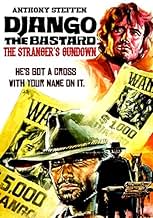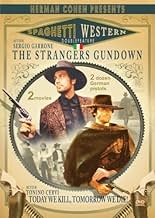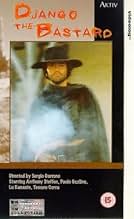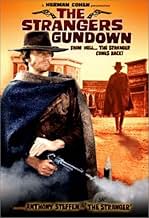ÉVALUATION IMDb
6,1/10
1,3 k
MA NOTE
Ajouter une intrigue dans votre langueA mysterious stranger appears to take terrifying revenge on former Confederate officers who during the Civil War betrayed and were responsible for the massacre of their unit.A mysterious stranger appears to take terrifying revenge on former Confederate officers who during the Civil War betrayed and were responsible for the massacre of their unit.A mysterious stranger appears to take terrifying revenge on former Confederate officers who during the Civil War betrayed and were responsible for the massacre of their unit.
Luciano Rossi
- Hugh Murdok
- (as Lu Kamante)
Thomas Rudy
- Rowland
- (as Tomas Rudi)
Artemio Antonini
- Hawkins Henchman
- (uncredited)
Ettore Arena
- Murdok Henchman
- (uncredited)
Fortunato Arena
- Murdok Henchman
- (uncredited)
Bruno Ariè
- Hawkens Henchman
- (uncredited)
Ennio Balbo
- Storekeeper
- (uncredited)
Ugo Ballester
- Town Businessman
- (uncredited)
Omero Capanna
- Shotgun
- (uncredited)
Histoire
Le saviez-vous
- GaffesDuring the first shootout Django shoots eight times from his six gun without reloading.
- Autres versionsTHe original Italian version of this film has a precredits explanatory scene: the betrayal of the confederates, and their subsequent massacre. For the English dubbed export version, this flashback was moved later in the film, and this is the version of the film available on DVD in America (from VCI) and on VHS in the UK (from Aktiv). The Italian DVD release contains the original Italian version of the film, with the flashback positioned before the credits as the filmmakers intended.
- ConnexionsReferenced in Django: The One and Only (2003)
Commentaire en vedette
This is the movie that got me into spaghetti westerns. I have been a huge fan of horror movies ever since I can remember, and I especially love the Euro-horror of the 60's and 70's. I also love horror-westerns like Curse of the Undead, and the infamous "bad" movie Billy the Kid vs. Dracula. There are only 2 or 3 other films that I would consider true horror-westerns, and I like those as well. Naturally, when I found out about this movie, I knew I had to have it.
I don't really think of this movie as a horror-western, since we never really know whether the stranger is supernatural or not, but it is a spaghetti western with a strong Gothic Euro-horror feel to it. This is the closest thing there is to a Euro-horror spaghetti western. It's a shame there was never a full-blown Euro-western horror film with an obvious ghost, vampire, zombies or the like. It could have have been incredible. Especially if Barbara Steele was in it. Anyway, I digress.
I don't consider this movie to be a sequel to the original Django film either. The stranger here is a man named Django, but we know he is not the same Django as the one in Sergio Corbucci's film, because this Django is a former confederate soldier. Corbucci's Django fought for the Union Army. This Django is like the grim reaper, a tall, emotionless, shadowy figure in black who calls himself a "demon from hell," and he is here to take the three officers who betrayed his regiment back down with him. He doesn't just kill, he does it with a macabre sense of style, which we first see in the opening scene of the film, where there is some great camera work as Django strolls into the middle of town, sticks a grave marker cross with the date and his first victim's name on it into the dirt in front of the saloon, and waits for the doomed man to come out and see it. It's an incredible scene, and that's just the beginning of Django's ghastly revenge. There are many more cool scenes after that one, but I won't spoil them.
The music is very creepy and atmospheric. It's an excellent score that could fit right into a Euro-horror movie, yet it is totally appropriate for a spaghetti western as well. There is even a part where it sounds like they are using a theremin. The constant sound of howling wind is also a nice touch.
In addition to the macabre, there is also some classic spaghetti western craziness in this film. Luke Murdoch, the brother of one of Django's targets, is one of the highlights of the movie. He is wildly insane, violent, over-the-top, and very entertaining to watch. There is also a scene near the beginning of the film where two men are playing catch with a lit stick of dynamite, and there is a crowd of people watching them, betting and cheering like it's America's favorite pastime. You've just gotta love this stuff.
There's some bad editing that makes me think that the original Italian version may have been longer, but it's a unique and interesting film in spite of whatever minor flaws it may have.
This was my first spaghetti western, and now I'm hooked on the genre. Need I say more?
I don't really think of this movie as a horror-western, since we never really know whether the stranger is supernatural or not, but it is a spaghetti western with a strong Gothic Euro-horror feel to it. This is the closest thing there is to a Euro-horror spaghetti western. It's a shame there was never a full-blown Euro-western horror film with an obvious ghost, vampire, zombies or the like. It could have have been incredible. Especially if Barbara Steele was in it. Anyway, I digress.
I don't consider this movie to be a sequel to the original Django film either. The stranger here is a man named Django, but we know he is not the same Django as the one in Sergio Corbucci's film, because this Django is a former confederate soldier. Corbucci's Django fought for the Union Army. This Django is like the grim reaper, a tall, emotionless, shadowy figure in black who calls himself a "demon from hell," and he is here to take the three officers who betrayed his regiment back down with him. He doesn't just kill, he does it with a macabre sense of style, which we first see in the opening scene of the film, where there is some great camera work as Django strolls into the middle of town, sticks a grave marker cross with the date and his first victim's name on it into the dirt in front of the saloon, and waits for the doomed man to come out and see it. It's an incredible scene, and that's just the beginning of Django's ghastly revenge. There are many more cool scenes after that one, but I won't spoil them.
The music is very creepy and atmospheric. It's an excellent score that could fit right into a Euro-horror movie, yet it is totally appropriate for a spaghetti western as well. There is even a part where it sounds like they are using a theremin. The constant sound of howling wind is also a nice touch.
In addition to the macabre, there is also some classic spaghetti western craziness in this film. Luke Murdoch, the brother of one of Django's targets, is one of the highlights of the movie. He is wildly insane, violent, over-the-top, and very entertaining to watch. There is also a scene near the beginning of the film where two men are playing catch with a lit stick of dynamite, and there is a crowd of people watching them, betting and cheering like it's America's favorite pastime. You've just gotta love this stuff.
There's some bad editing that makes me think that the original Italian version may have been longer, but it's a unique and interesting film in spite of whatever minor flaws it may have.
This was my first spaghetti western, and now I'm hooked on the genre. Need I say more?
- spider89119
- 2 avr. 2006
- Lien permanent
Meilleurs choix
Connectez-vous pour évaluer et surveiller les recommandations personnalisées
- How long is Django the Bastard?Propulsé par Alexa
Détails
- Date de sortie
- Pays d’origine
- Langue
- Aussi connu sous le nom de
- Django the Bastard
- Lieux de tournage
- Villa Mussolini, Rome, Lazio, Italie(The residence of Major Rod Murdok)
- sociétés de production
- Consultez plus de crédits d'entreprise sur IMDbPro
- Durée1 heure 38 minutes
- Mixage
- Rapport de forme
- 2.35 : 1
Contribuer à cette page
Suggérer une modification ou ajouter du contenu manquant

Lacune principale
By what name was Django il bastardo (1969) officially released in India in English?
Répondre






















